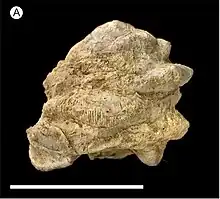| Cheirolepidiaceae Temporal range: | |
|---|---|
 | |
| Leafy shoot of Tomaxellia showing details of epidermis and stomata | |
| Scientific classification | |
| Kingdom: | Plantae |
| Clade: | Tracheophytes |
| Clade: | Gymnospermae |
| Division: | Pinophyta |
| Class: | Pinopsida |
| Order: | Pinales |
| Family: | †Cheirolepidiaceae Turutanova-Ketova 1963 |
| Genera | |
| |
| Synonyms | |
| |
Cheirolepidiaceae (also spelled Cheirolepidaceae) is an extinct family of conifers. They first appeared in the Triassic, and were widespread during most of the Mesozoic era. They are united by the possession of a distinctive pollen type assigned to the form genus Classopollis. The name Frenelopsidaceae (as a separate family) or "frenelopsids" has been used for a group of Cheirolepidiaceae with jointed stems, thick internode cuticles, sheathing leaf bases and reduced free leaf tips. The leaf morphology has been noted as being similar to that of halophyte Salicornia. Several members of the family appear to have been adapted for semi-arid and coastal settings, with a high tolerance of saline conditions.[1] Cheirolepidiaceae disappeared from most regions of the world during the Cenomanian-Turonian stages of the Late Cretaceous, but reappeared in South America during the Maastrichtian, the final stage of the Cretaceous, increasing in abundance after the K-Pg extinction and being a prominent part of the regional flora during the Paleocene, before going extinct.[2]

The habit of cheirolepidaceous confers is likely to have varied widely, from large trees (some with trunks over 3 metres (9.8 ft) thick at their base) to shrubs.[3][4] Their architecture is poorly known, though some are thought to have had decurrent spreading crowns, while others had conical crowns. Many seem to have plagiotropic lateral branches that developed in whorls.[4]
The relationships of Cheirolepidiaceae to other conifers are uncertain. A close relationship with Araucariaceae and Podocarpaceae has been proposed, based on the similarities of their reproductive structures,[5] though other studies have suggested that they may fall outisde the crown group of modern conifers among various voltzialean lineages.[6]
At least some species of Cheirolepidiaceae have been suggested to have been pollinated by insects, due to the construction of the reproductive organs and the fact that insects have been found associated with Classopolis pollen grains.[7][8]
The family name Hirmeriellaceae is a junior synonym of Cheirolepidiaceae.[9] Some authors have suggested Hirmeriellaceae is the valid name for the family, due to nomenclatural issues with the original Cheirolepis genus, which is a junior homonym of a member of Asteraceae, with Cheirolepidium suggested to be an invalid replacement. Both genera are likely synonyms of Hirmeriella.[10]
Genera
- †Agathoxylon (wood, in part)
- †Brachyoxylon (wood)
- †Classopollis (pollen)
- †Classostrobus (pollen cones)
- †Dicheiropollis (pollen)
- †Frenelopsis (foliage)
- †Hirmeriella (whole plant)
- †Pararaucaria (ovulate cones)
- †Pseudofrenelopsis (foliage)
- †Watsoniocladus (foliage)
- †Brachyphyllum (foliage, in part)
- †Tomaxiella (foliage and ovulate cone)
- †Kachaikestrobus (ovulate cones)
- †Alvinia (ovulate cones)
- †Pseudohirmeriella (ovulate cones)
References
- ↑ Escapa, Ignacio; Leslie, Andrew (2017). "A new Cheirolepidiaceae (Coniferales) from the Early Jurassic of Patagonia (Argentina): Reconciling the records of impression and permineralized fossils". American Journal of Botany. 104 (2): 322–334. doi:10.3732/ajb.1600321. ISSN 1537-2197. PMID 28213347.
- ↑ Barreda, Viviana D.; Cúneo, Nestor R.; Wilf, Peter; Currano, Ellen D.; Scasso, Roberto A.; Brinkhuis, Henk (2012-12-17). Newsom, Lee A. (ed.). "Cretaceous/Paleogene Floral Turnover in Patagonia: Drop in Diversity, Low Extinction, and a Classopollis Spike". PLOS ONE. 7 (12): e52455. doi:10.1371/journal.pone.0052455. ISSN 1932-6203. PMC 3524134. PMID 23285049.
- ↑ Taylor, T (2009), "Conifers", Biology and Evolution of Fossil Plants, Elsevier, pp. 805–871, doi:10.1016/b978-0-12-373972-8.00021-8, ISBN 978-0-12-373972-8, retrieved 2023-02-08
- 1 2 Steart, David C.; Needham, John; Strullu-Derrien, Christine; Philippe, Marc; Krieger, Jonathan; Stevens, Lil; Spencer, Alan R. T.; Hayes, Peta A.; Kenrick, Paul (2023-04-12). "New evidence of the architecture and affinity of fossil trees from the Jurassic Purbeck Forest of southern England". Botany Letters: 1–18. doi:10.1080/23818107.2023.2197973. ISSN 2381-8107.
- ↑ Jin, Peihong; Zhang, Mingzhen; Du, Baoxia; Li, Aijing; Sun, Bainian (February 2023). "A new species of Pararaucaria from the Lower Cretaceous of Shandong province (Eastern China): Insights into the Evolution of the Cheirolepidiaceae cone". Cretaceous Research: 105475. doi:10.1016/j.cretres.2023.105475.
- ↑ Andruchow-Colombo, Ana; Escapa, Ignacio H; Aagesen, Lone; Matsunaga, Kelly K S (2023-08-04). "In search of lost time: tracing the fossil diversity of Podocarpaceae through the ages". Botanical Journal of the Linnean Society. doi:10.1093/botlinnean/boad027. ISSN 0024-4074.
- ↑ Ren D, Labandeira CC, Santiago-Blay JA, Rasnitsyn A, Shih CK, Bashkuev A, Logan MA, Hotton CL, Dilcher D. (2009). Probable Pollination Mode Before Angiosperms: Eurasian, Long-Proboscid Scorpionflies. Science, 326 (5954), 840-847.doi:10.1126/science.1178338
- ↑ Peñalver, Enrique; Arillo, Antonio; Pérez-de la Fuente, Ricardo; Riccio, Mark L.; Delclòs, Xavier; Barrón, Eduardo; Grimaldi, David A. (July 2015). "Long-Proboscid Flies as Pollinators of Cretaceous Gymnosperms". Current Biology. 25 (14): 1917–1923. doi:10.1016/j.cub.2015.05.062.
- ↑ Herendeen, P., 2015. Report of the nomenclature committee on fossils. 9. Taxon (64) 6: 1306-1312
- ↑ Doweld, Alexander B. (October 2020). "The controversial nomenclature of the fossil plant names Cheirolepis , Cheirolepidium and Hirmeriella (Cheirolepidaceae/Cheirolepidiaceae/Hirmeriellaceae)". Taxon. 69 (5): 1092–1098. doi:10.1002/tax.12287. ISSN 0040-0262. S2CID 225425644.